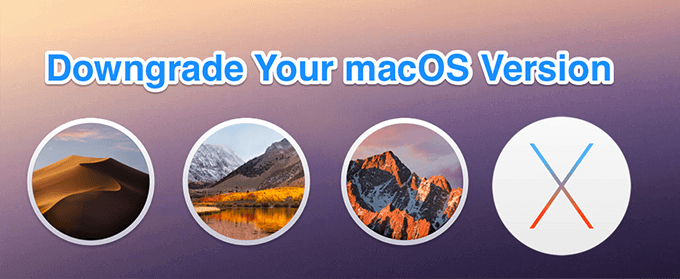Normally, most macOS updates don’t cause any problems on your Mac. However, there are times when some updates break functionality and make your system faulty. If you’ve been a victim of such a problem, you may want to roll back the update on your Mac.
However, going back to your favorite old version of macOS isn’t easy. There is simply no option anywhere on the Mac that will allow you to downgrade macOS to an older version of the operating system.

That’s not to say there isn’t any method to downgrade macOS on your Mac. There are a couple of ways to help you roll back the update and go back to the version of macOS you are running before updating your computer.
Downgrade macOS by restoring a Time Machine backup
If you’ve been a Mac user for a while, you probably already know what a Time Machine backup is. It’s a full backup of your Mac containing all your files, apps, and even system files.
The great thing about a Time Machine backup is that it also backs up your operating system. This means that if you created a Time Machine backup before upgrading to the latest version of macOS, you can restore the backup and get your Mac downgraded.
Restoring the backup restores all files, apps, and the previous version of macOS that you had when you backed up.
- Turn off your Mac by clicking on the Apple logo at the top and selecting Stop.


- The macOS Utilities list will appear on the screen. Click on the first one in the list that says Restore from Time Machine backup to restore the backup.

- You will be asked to choose the disk on which to save the backup. Select your disk from the list on the screen and click Keep on to proceed with the backup restore.


- Select your primary Mac drive on the following screen and press Restore. It will replace all the contents on your disk with those from your backup.

Restart your Mac when the backup is restored and you will revert to an earlier version of macOS.
Downgrade macOS by installing an older version of macOS
If you didn’t create a Time Machine backup before updating to the latest macOS, you can’t use the method above. However, Time Machine isn’t the only way to downgrade the macOS version on your Mac.
You can download and install a new version of an old macOS on your Mac. This will bring your machine to the chosen version of the operating system. Note that this will erase all data on your Mac.
There are three steps to using this method.
Download an old version of macOS
Since you’ll be installing a fresh copy of macOS, you’ll need to download the entire operating system to your Mac first.
If you search the official Mac App Store as you normally do to find new versions of macOS, you’ll just be disappointed. It’s because, although the App Store has older versions of the operating system available for download, they don’t always show up in search results.
Your best option is to use the direct download links given below to get your preferred version of macOS for your Mac.
Once the file is downloaded, don’t open it yet. Move it up Applications folder using the Finder.
Create a bootable USB installer for macOS
You will now create a bootable USB installer for your chosen macOS version. You will use this USB to perform a fresh installation of the operating system on your Mac.
- Connect a 12GB or larger USB drive to your Mac. Make sure there is no content.
- Open a Finder window and note the volume name of the USB drive.
- Click on Springboard in the Dock, search terminaland launch the app on your Mac.

- When Terminal opens, type one of the following commands that match your version of macOS and press log into. Be sure to replace My volume with the USB drive name noted in step 2.
macOS Mojave:
sudo /Applications/Install\ macOS\ Mojave.app/Contents/Resources/createinstallmedia – volume /Volumes/MyVolume
macOS High Sierra:
sudo /Applications/Install\ macOS\ High\ Sierra.app/Contents/Resources/createinstallmedia – volume /Volumes/MyVolume
macOS Sierra:
sudo /Applications/Install\ macOS\ Sierra.app/Contents/Resources/createinstallmedia – volume /Volumes/MyVolume – applicationpath /Applications/Install\ macOS\ Sierra.app
macOS El Capitan:
sudo /Applications/Install\ OS\ X\ El\ Capitan.app/Contents/Resources/createinstallmedia – volume /Volumes/MyVolume – applicationpath /Applications/Install\ OS\ X\ El\ Capitan.app

- Enter your password when prompted and it will start creating your bootable USB installer.
- Your USB drive should now be ready and you can start downgrading macOS.
Install an old version of macOS
What you will do is boot your Mac from the newly created bootable installer. It will then allow you to install your preferred version of macOS on your Mac.
- Turn off your Mac.
- Turn on your Mac and hold down the key Option key.
- Startup Manager will open on the screen. Select your USB drive to boot your Mac from it.

- Follow the onscreen instructions to install macOS.
- Your Mac should now be downgraded.